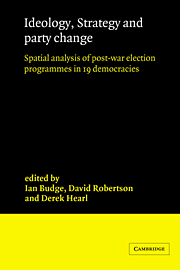 Ideology, Strategy and Party Change
Ideology, Strategy and Party Change Published online by Cambridge University Press: 27 October 2009
The bulk of this book presents separate analyses of fifteen democratic party systems, using a common methodology. We begin however, with a more compact study of four nations, sharing an ‘Anglo-Saxon’ political culture and a system of two dominant parties. Two (Britain and the United States) have already been analysed in detail using similar methodologies (Robertson 1976; Budge and Farlie, 1977, Chapter 11). So it has been established that the structure of party competition in Britain and the United States can usefully be examined through a saliency coding of party programmes subjected to Factor Analysis. The other two are frequently associated with an Anglo-Saxon political culture (Alford 1962) or treated as examples of the export of the ‘Westminster Model’ (Butler 1963), thus they permit a natural extension of the technique and approach.
POLITICAL PARTIES
Britain and the United States have so often been discussed as prototypes of the two-party competitive system or used as the starting point for a discussion of other systems that the leading features of their party politics need only be summarized here.
American parties
The United States, though so familiar, has perhaps the most atypical parties and elections of all. Its parties have the oldest continuous history, dating in something like their present form to the 1860s.
To save this book to your Kindle, first ensure no-reply@cambridge.org is added to your Approved Personal Document E-mail List under your Personal Document Settings on the Manage Your Content and Devices page of your Amazon account. Then enter the ‘name’ part of your Kindle email address below. Find out more about saving to your Kindle.
Note you can select to save to either the @free.kindle.com or @kindle.com variations. ‘@free.kindle.com’ emails are free but can only be saved to your device when it is connected to wi-fi. ‘@kindle.com’ emails can be delivered even when you are not connected to wi-fi, but note that service fees apply.
Find out more about the Kindle Personal Document Service.
To save content items to your account, please confirm that you agree to abide by our usage policies. If this is the first time you use this feature, you will be asked to authorise Cambridge Core to connect with your account. Find out more about saving content to Dropbox.
To save content items to your account, please confirm that you agree to abide by our usage policies. If this is the first time you use this feature, you will be asked to authorise Cambridge Core to connect with your account. Find out more about saving content to Google Drive.